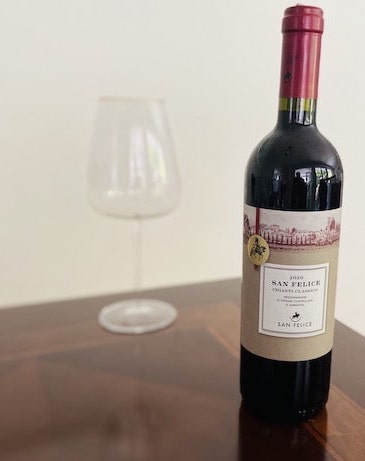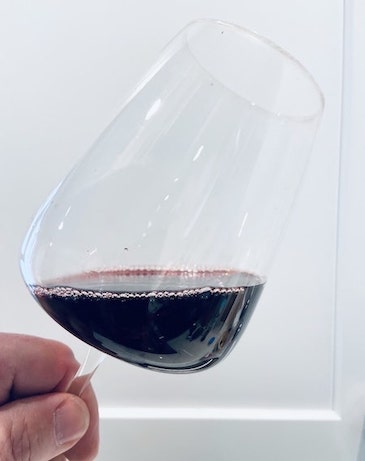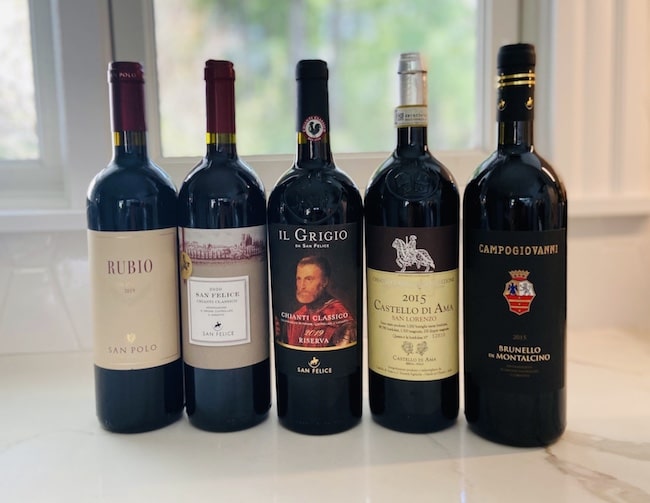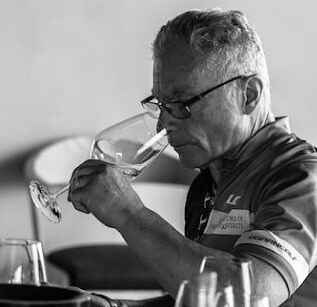Chianti is a fruity, medium-bodied red wine that comes from Tuscany, a wine region in central Italy, and Sangiovese is the name of the primary grape variety used to make Chianti. To be called Chianti, a wine must be a blend of 70% or more Sangiovese grapes. So in a sense, all Chianti wines are Sangiovese.
The confusing thing is they are not called Sangiovese because Chianti is a particular region and most wines from this part of Italy are named after the region where they are produced, not the grape varieties they contain.
So what if you find a wine that is actually called Sangiovese? It may be a wine made from Sangiovese from another growing region in Italy, for example, Emilia-Romagna. It could also be a wine from Tuscany that doesn’t meet the regulations put in place for it to be called Chianti. It’s also possible for it to be from another place in the world, like Australia or Argentina (though it is fairly unusual to find Sangiovese grapes grown outside of Italy where they seem to do best).


Understanding Chianti DOC and Chianti Classico DOCG wines
Chianti DOC is the largest wine growing area of Tuscany. The DOC stands for “Denominazione di Origine Controllata.” Every country has their own rules and regulations for wine and grape growing. In the US, there’s a general law that covers most of the country but in places like Italy, where wine is an important national product, each specific region has their own laws and regulations.
As a rule of thumb, if you see Chianti DOC on the label, you know you have an Italian wine of a specific quality. If there is a G at the end, as in Chianti Classico DOCG, the wine is even higher quality.
A quick guide to the major Sangiovese wine growing areas of Tuscany
Chianti DOC
To be considered Chianti DOC, a wine must be made from at least 70% Sangiovese grapes and can be released after 8 months of aging in either barrel or bottle.
Chianti Classico DOCG
The Chianti Classico DOCG is a smaller area within the Chianti wine district where grape quality is higher and growing conditions can produce a superior wine. Chianti Classico has higher and stricter wine making and aging regulations. For example, it must be made up of 80% Sangiovese grapes with the remaining grape percentage coming from approved varietals in particular wine growing areas. This wine is typically aged in large barrels, must be at least 12% alcohol and can be released on October 1st of the year after the grape harvest.
Chianti Classico Riserva
A Riserva is a more complex and structured wine made from Sangiovese. It must be a minimum of 12.5% alcohol and is aged for 24 months in barrels or bottles.
Chianti Classico Riserva “Gran Selezione”
This Sangiovese based wine has a much smaller production. It must be a minimum of 13% alcohol and is aged for 30 months. A Gran Selezione Riserva wine is estate grown and bottled and each vintage has to pass a certification.
Wine Fact: Why are alcohol percentages part of the guide specifications for wine quality? It’s because grapes with higher sugar content have different characteristics. They’re often bigger, richer and have more concentrated flavors. Sugars are converted into alcohol so these more complex grapes lead to higher alcohol percentage wine.

Other Italian wines made from Sangiovese
Brunello di Montalcino DOCG
Brunello di Montalcino is a wine made from a different sub variety of Sangiovese called Sangiovese Grosso, grown southeast of the Chianti Classico region. The main difference is this area is a little warmer and these Sangiovese grapes tend to be more intense and richer, producing a wine that has more body to it than a Chianti. These wines are made up of 100% Sangiovese grapes and must be aged for 4 years, with at least 2 years spent in bottles.
Vino di Nobile di Montepulciano DOCG
Vino di Nobile di Montepulciano is a wine from the most southeastern part of Tuscany. Here they call the Sangiovese grape Prugnolo Gentile. These wines must be at least 70% Sangiovese, but you will find most bottles are closer to 80 or 90% Sangiovese. This wine is 12.5% alcohol and aged for 24 months, with 12 months spent in barrels.
Carmignano DOCG
Carmignano is a small grape growing area in central Tuscany where wines must be at least 50% Sangiovese grapes. Despite this, you will find they are usually 70-90% Sangiovese. They’re also commonly blended with Cabernet Sauvignon, Cabernet Franc or Merlot. These wines are aged for at least 18 months and spend 8 months in barrels.
6 Things to consider when you’re choosing a wine made from Sangiovese grapes
- Think about the food you’ll be having the wine with. A Sangiovese based wine, like a simple Chianti, can be fruity and have flavors like cherry and plum. It can also be more medium in body with a more subtle flavor. It would be okay on its own but wines made with Sangiovese grapes are best served with food. The difference is they’re higher in acidity and they have more restraint to their fruit than a Cabernet, for example. You could pair a Chianti with Italian dishes like pizza or red sauces, think Bolognese, Eggplant Rollatini, or Veal Parmesan. A Chianti Classico Riserva on the other hand, goes well with white meats, for example Veal Saltimbocca, Lamb Ossobuco, or Pappardelle with Wild Boar. The best food pairing for a Brunello, which has more body to it, would be a filet or roast lamb.
- Look for something from a known producer. Antinori is a reputable producer with a range of great wines. For Chianti Classico look for San Felice, Castello di Ama, Barone Ricasoli, Badia Coltibuono or Castello di Volpaia. If you’re just looking for a Chianti, Banfi, Gabbiano and Vecchia Cantina make nice wine, and for a Sangiovese, Monte Antico, San Polo, Ruffino and Carparzo are worth trying. Some of the better known Brunello di Montalcino producers are San Felice Campogiovanni, Caparzo, Poggio Antico, San Polo, Banfi, and Bondi Santi. For a Vino di Nobile di Montepulciano you might try Boscarelli, Carpineto, or Poliziano, and for a Carmignano, Villa Capezzana. Depending on where you are, these are Italian wines you should be able to find at your local wine store or on a restaurant wine list.
- Consider your budget. As a general guide, a bottle of Chianti or Sangiovese can be between $10 – $15, whereas a Chianti Classico might be closer to $15 or $20. Expect to pay $25 -$35 for a Riserva, $45 – $85 for a Gran Selezione, $50 – $125 for a Brunello, $20 – $45 for a Vino di Nobile di Montepulciano, and $20 – $45 for Carmignano. Remember, just because a wine is more expensive, it doesn’t mean it’s better. The best wine is the one that fits your budget and is right for the food you are having it with.
- Try new wines from time to time. If you see a wine called Sangiovese, it means it’s made from Sangiovese grapes but they might be from another region outside of Chianti. Either that, or it doesn’t meet the specifications to be called Chianti Classico. Does this make it a bad wine? Absolutely not! It’s probably a great everyday drinking wine and it might be your best option if you’re looking for something reasonably priced. Never be afraid to try new wine as you are learning about a particular region or grape.
- Keep an eye out for the rooster. The symbol for Chianti Classico is a black rooster. To decide the border for where the Brunello and Chianti Classico wine growing areas started, two of the major city-states in 13th century Tuscany, Florence and Siena, each sent a rider on horseback who would leave at dawn. In Florence, they chose a black rooster to wake the rider. The black rooster crowed early and Florence enjoyed such an advantage that the border was established just outside of Siena, near Fonterutoli, with most of the Chianti Classico wine region belonging to Florence.
- Don’t be surprised if you see Merlot or Cabernet Sauvignon on the back label. Chianti Classico and Riserva wines can be made with a certain percentage of grapes that are not Sangiovese. For example, a Chianti wine could be 30% other grapes and these might be a blend of Merlot and/or Cabernet as well as other locally approved grape varietals.
The best food pairing for Sangiovese and Chianti
Let your wine be your guide when it comes to food pairings. For simple medium body wines like Sangivoese and Chianti, traditional Italian food will go perfectly. If you’re not at an Italian restaurant, you can also drink Sangiovese and Chianti with grilled red meat. This is especially true of ribs. The acidity and the red fruit flavors in the wine will complement the spice. If you’ve opted for a slightly more expensive wine like a Chianti Classico, you could also try a tuna steak.
The more complex and refined flavors of a Chianti Classico Riserva or Gran Selezione best complement complex meat dishes made with veal or lamb. A Brunello di Montalcino is good with meaty foods like a roast, Vino di Nobile di Montepulciano goes well with steak and richer pasta sauces.
Note, wines made from Sangiovese grapes also complement lighter summer meals like salads. That’s because they have higher acidity and flavors of red fruit. If it’s a warm evening, you could serve the wine slightly chilled, at 60 to 65 degrees. Keep in mind that while these wines can have fruity notes of cherry and red currant, they don’t necessarily pair well with dessert food – though a Chianti Classico does go well with chocolate cake!
What Sangiovese is not
If you like red wine that is full in body and has big flavors and intensity, like a Napa Cabernet Sauvignon for example, Sangiovese wines may not be for you (with the exception of Brunello, see above for more on the characteristics of this wine). If you’re at an Italian restaurant and your choices are limited, you could try a Super Tuscan which is usually a Cabernet and Merlot based Italian wine.






Congratulations on the launch of this project. I look forward to reading each one as they are released.
Phil T.
I knew you’d appreciate this being in the wine business yourself!